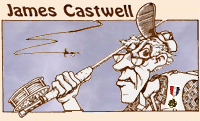|
The Ladyfisher said I should write about this anyway.
"Darn it, Honey," I said this morning after watching
a half-hour fishing show on T.V., "I just watched (name
withheld to protect the innocent) playing some big fish
and he was doing everything right! I write about this
stuff and half of our readers argue with me. Why can't
I seem to get through to 'em?"
"No idea, but why not let them have it again. Let them
know what you saw and why it worked. It's alright to repeat
a subject, 'specially if you think it might help someone.
Ok?"
So with that encouragement I shall proceed with reckless
abandon. Except I will not give you the name of the guy
I am writing about. For this his name is not important,
what and how he did things is. If you think you know who
he is, don't let me know, there won't be a prize. The only
winners are those who may take some of this to heart (brain)
and put it to use. You may improve your landing ratio if
do some of the following methods.
I will start with the fly. Little thing, size eight un-weighted
nymph on eight pound tippet. He is fishing for twenty-plus pound
fish, brown trout in a heavy river. Why such a small fly and
light tippet? Because he wants a natural drift. Free-flowing,
no drag, tumbling just over the bottom. Will he snag a few
times and lose a few flies? He better or he isn't doing it
right. When the conditions and the fish require certain
methods, then you better be willing to do them or stay home.
Larry (oops, almost gave it away) makes his first cast as
far upstream (to his right side) as he can reach and slips
line into the cast as he 'reaches' on the presentation. A
quick flip-mend or two (or three) and he follows the drifting
fly line with his rod tip as it floats from his right to his
left on the surface. A floating line with a leader long enough
to allow the fly to drop to the bottom if presented correctly.
He did and he caught fish because of it.
How many times have I seen guys cast straight out, let it
start to sink, it speeds up due to the current and is lucky
to get an inch under the surface. So they put some weight
on it. And they wonder why a fish doesn't grab it. A sinker
with feathers. Oh well. I suppose the occasional fish is
better than none at all. By proper casting, presentation
and mending it is usually possible to get a fly down to
the correct depth. Not always, true. But much of the time.
So now he has a real fish not a small gob of flotsam from
the stream bed. The fish wants to slug it out right where
it is at first; jumps, rolls, thrashes and flops. He raises
his rod to clear as much line as possible from the surface
thereby reducing drag but while his arm is held high, the
rod is not pointed up, but nearly straight at the fish for
the maximum force. At one point he puts his left hand on
the rod above the cork, but not in a heavy way, just enough
to spread the work between his hands. When the fish tires
of that game it slowly loses position and drifts downstream,
with him in hot pursuit, trotting along the bank, staying
directly opposite the fish. The fish is ninety degrees from
the bank here and the angler fiercely maintains it.
Eventually the contest changes and he regains some fly line.
The twenty pounder has been unrelentingly drawn into the
shallows of the gravel lined stream and now makes a nice
soft landing. His nose is nearly poking out of the water.
Meanwhile the angler has been backing up, pressure now
applied directly to the lowered rod, literally towing
the fish toward the beach.
At this exact point while holding the rod still pointed
at the fish, he extends his arm and circles into the
water, in back of the fish. If the fish should bolt
for the deep he can swivel the rod which is now
overhead and follow the fish without any fear of
losing him. Since the fish is however nose-toward-shore,
he easily reaches down and with his other hand tails it
and nudges it onto the beach. Never once did he point
his rod 180 degrees from the fish. So often that is
the cause of many a 'factory-defect' which only shows
up on larger fish (which shake their head while the
angler has the rod pointed straight up and the tip
must burst at that point).
So, anyway, I watched him for the half-hour and am
glad to see that he did it all right. No big secrets,
nothing special, just that I do not get to see it
done that way often. Well, often enough anyway. ~ JC
|



